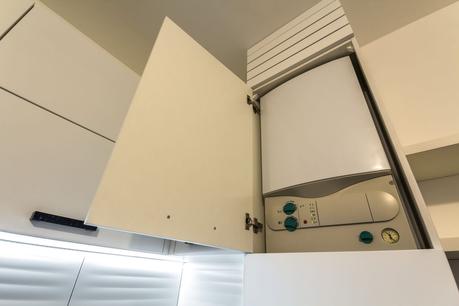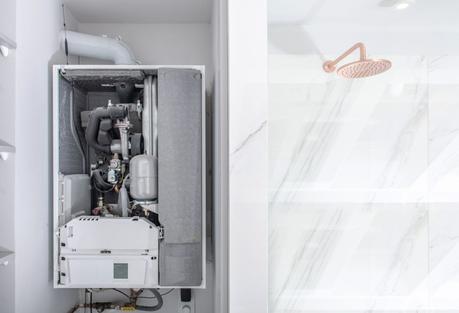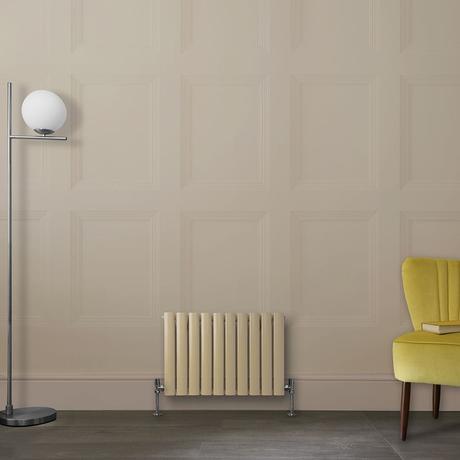What we’ll cover…
- Understanding a boiler cupboard
- Outlining the importance and purpose of a boiler cupboard
- Safety considerations
- Which items to avoid storing in a boiler cupboard
- Fire safety advice
- Effective organisation strategies
- Storage and shelving solutions
- Tips for decluttering
- Creative uses for a boiler cupboard
- Alternative storage options
- How to utilise space for utility needs
- Maintenance and ventilation tips
- The completion of regular checks and servicing
- How to improve airflow around the boiler
- Conclusion and best practices
- Recap of key points and final advice
Safe and effective boiler cupboard tips
A boiler cupboard is a staple inclusion in many UK homes, and an increasingly popular vice for homeowners aiming to maximise space and retain a sleek and uncluttered appearance. That said, the proper and correct usage of a boiler cupboard is vital to safety, efficiency and compliance with regulations. In this guide, we’ll discuss everything you need to know about the proper utilisation of your boiler cupboard, helping to ensure all your home radiators or alternate heating devices are operating to their full capacity in turn.
Boiler cupboards – what not to do
When it comes to assessing the setup and contents of a boiler cupboard, it is often more about what not to do than what to include within the confined space. Some measures to avoid are listed as follows…

Flammable item storage
The storage of flammable materials such as aerosols, cleaning products and paint cans anywhere close to the boiler is strongly recommended against, given it poses a serious fire hazard. The heat emitted from the boiler could potentially lead to these items igniting, so they should be removed from a boiler cupboard if they are situated there.
Ventilation blockages
Stocking up items in and around the boiler can cause obstructions to proper airflow, ultimately resulting in ventilation blockages. In turn, efficiency levels are reduced, whilst overheating and incomplete fuel combustion become possible byproducts as well. In the worst case scenarios, life-threatening carbon monoxide emissions can ensue, that are unable to be detected via sight, taste or smell.
That said, proper ventilation is vital in a boiler cupboard setting. The majority of modern combi boilers won’t necessitate any additional ventilation measures provided they are fitted in a cupboard with sufficient clearance space. You should however consult the manufacturer instructions to double-check on any specific ventilation requirements. The key is to make sure there is adequate room around the boiler for the circulation of air. It is advised to leave 300mm above and 100mm below the unit.

Maintenance access prevention
A boiler cupboard that is overfilled can pose a difficult prospect for plumbers or heating engineers to access the unit to complete a boiler service or repair. In turn, access issues can lead the boiler to be neglected from frequent necessary maintenance, and spawn safety problems you would rather avoid. On a more minor scale, you can create a headache for yourself when it comes to gaining access to the cupboard when you need it and having to put everything back in place.
You should keep a proper clearance space surrounding the boiler for easy service and maintenance access, including 700mm of space at the boiler front. Make sure the cupboard door can open fully without any obstructions.
Damp item storage
Though it might seem convenient – especially so in the case of boiler cupboards located in the bathroom – the placement of damp clothing or wet towels in the space can facilitate excess moisture. This can lead to the growth of mold and mildew, which could eventually compromise boiler components through corrosion over time, costing for repairs or replacements and risking the safety of the appliance. Heated towel rails or clothes maidens are examples of viable alternatives to dry clothing, linen and towels.
General storage usage
Treating a boiler cupboard as a general storage area is a no-no – it enhances the chances of items falling onto or damaging the boiler. Primarily, look to keep the space dedicated to the boiler and minimise the amount of related items stored within to decrease the risk of potential damage occurring.
Pressure relief valve blockage
A pressure relief valve is a vital safety mechanism within a boiler system. It is used mainly for the prevention of excessive pressure build-up within the boiler, which, left unchecked, could result in catastrophic system failure.
Essentially, the relief valve is designed to automatically open and release excess pressure if it builds beyond safe levels within the boiler. There are numerous reasons that can cause this to happen, such as system blockages or malfunctioning temperature controls.
If items situated in the boiler cupboard are positioned in a way that impedes the pressure relief valve, it could mean it will not be able to open fully or at all when required and cause a build-up of excess pressure. In the most extreme of situations, this could be a catalyst for a boiler explosion, which could pose a threat of life-altering or ending injures as well as immense property damage.
Extra safety measures for boiler cupboards
As a further safety measure in a boiler cupboard, you can invest in some safety equipment for peace of mind. A carbon monoxide detector is one such item that can be installed nearby the cupboard to provide alerts when levels are becoming excessive.
You might also decide to take further precautions in the form of a suitable fire extinguisher; this should also be positioned close to the boiler cupboard, but not within it.

The safe usage of a boiler cupboard
All in all, the proper management of a boiler cupboard is vital with regards to safety and efficiency. In dodging the common mistakes outlined in this article, you will not only protect your property against water damage and potential fire hazards, but also ensure optimal boiler performance.
Correct boiler storage practices will enhance the system’s lifespan, prevent the need for costly repair work, and facilitate lower energy bills. The key factor in achieving this is to always think of the boiler cupboard as an area of functionality for your heating system as opposed to a general storage space.
Ultimately prioritise safety and efficiency over convenience when managing your boiler cupboard for a safer, more comfortable and energy efficient home. Should you be unsure about how to implement the aforementioned best practices, you can consult a professional plumber for assistance.
And don’t forget to check out all the hints and tips in the BestHeating Advice Centre, or hesitate to get in touch with us for further heating assistance. We can be reached in the comments section below, or via Instagram, Facebook or X.
Frequently Asked Questions
bCan I store items in my boiler cupboard?
Although it is generally acceptable to store some household items in a boiler cupboard, it is essential to avoid placing flammable materials within, or anything that could potentially obstruct airflow surrounding the boiler. This will enable the proper performance and maintenance of a boiler, allowing home radiators and other heating devices to work to their full potential.
Recommended storage items include cleaning supplies, spare linens or non-flammable items.
For more insights into modern boilers and their usage, explore our article, The (improved) BestHeating guide to buying a boiler.
Share View FAQ Page bHow does a boiler lose pressure?
The most common cause of a boiler losing pressure is from leaks forming on radiators, the boiler itself or attached pipework, or from internal faults within the central heating system. When left unattended, this can spiral towards fully fledged boiler and overall home heating troubles.
To find out how to combat the problem, and return your boiler to its ideal pressure levels, explore our blog, Why does my boiler keep losing pressure?
Share View FAQ Page bCan boiler pressure stop downstairs radiators from working?
Low boiler pressure can stop downstairs radiators from heating up adequately, as the water isn’t pressurised enough to transport heat from the central heating system all the way down to your downstairs home radiators.
To find out more, explore our dedicated blog, Why are my downstairs radiators not working?
Share View FAQ Page bWhen is the best time to get your boiler serviced?
Summertime is the best time to get your boiler serviced.
Simply, there’ll be far less demand and thus shorter waiting times as it pertains to calling out a plumber, and less pressure regardless for any heating issues to be quickly given the warmer outdoor temperatures.
Furthermore, you’ll be confident your boiler is in tip-top shape and ready to supply the necessary hot water to your home radiators as the colder climate materialises during the winter.
To find out more, explore our blog, Summer Heating & Radiator Tips.
Share View FAQ Page bShould I turn off my boiler if it is leaking?
Although it isn’t overtly dangerous, a leaking boiler should be switched off to prevent the chance of your electrics short-circuiting, and to stop escaped water from damaging flooring, fittings and furniture.
You should never attempt to fix a leaking boiler by yourself, and instead enlist the services of a Gas Safe registered engineer.
To learn more about your boiler and to understand when you should seek to get it serviced, check out our Boiler Service Guide.
Share View FAQ Page bHow long will an average boiler last?
The lifespan of an average boiler, in proper working order, is expected to be between 10 to 15 years.
You should ensure the boiler is well maintained, and serviced on an annual basis, to keep it fully operational for as long as possible.
Share View FAQ Page bWhat is the danger if a boiler is not serviced regularly?
Boilers should be serviced at least once a year to make sure they are running safely and efficiently.
A faulty boiler could expose household inhabitants to a risk of carbon monoxide poisoning.
Furthermore, boiler servicing can help you identify leaks and other potential issues early, helping to prevent massive repair costs from building up.
Share View FAQ Page
